Papers by Journal Revista de lenguas para fines específicos
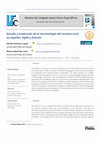
Revista de lenguas para fines específicos, 2019
La traducción es una cuestión esencial en el área del turismo, dado que los productos y los servi... more La traducción es una cuestión esencial en el área del turismo, dado que los productos y los servicios turísticos deben ser promocionados en los diferentes mercados en diferentes lenguas para que estén al alcance de comunidades lingüística y culturalmente muy distintas. Este trabajo presenta un análisis exhaustivo de los términos característicos del turismo rural en tres lenguas: español de España, inglés y francés. El principal objetivo es obtener los equivalentes de traducción más adecuados para los diversos tipos de alojamiento de turismo rural. Con ello esperamos diseñar herramientas útiles para traductores, diseñadores de sitios web y profesionales y agentes implicados en la industria del turismo. Esta investigación se inició en el año 2010 y se encuentra aún en proceso de realización, mediante la recopilación de textos en las tres lenguas de estudio y la ampliación de la base de datos en la que se almacenan los resultados del análisis de dichos textos.
Revista de lenguas para fines específicos, 2019
This paper presents Blogging as a tool to promote competence in written production in the English... more This paper presents Blogging as a tool to promote competence in written production in the English language. The application of Blogging in learning English for specific purposes (ESP) and, in particular, in teaching English at Vocational Training is analyzed, dealing with the area of English in the field of Tourism. We aim at verifying whether the students, who participated in the experiment, have improved their competence in written production through Blogging according to the principles by Project-Based Learning (PBL).
Revista de lenguas para fines específicos , 2019
The cultural content of textbooks has become an important issue since the main goal of teaching E... more The cultural content of textbooks has become an important issue since the main goal of teaching English as a foreign language has shifted from communicative competence to intercultural citizenship. This paper reviews the trends in teaching culture in EFL and examines different approaches to the cultural analysis of textbooks. Then, our study analyses the cultural content of two editions of an intermediate (B1) EFL textbook using our own cultural content checklist. By comparing older and more recent editions, we examine how comprehensive the cultural content is in each book and determine how many thematic categories are covered in both textbooks.
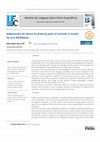
The growing flow of the foreign Tourism to Spain demands competent and well-trained professionals... more The growing flow of the foreign Tourism to Spain demands competent and well-trained professionals. One of the fundamental areas of training is foreign language, and therefore, they must dominate both: the general language and the specific one that implies the precise knowledge of a specialized lexicon not always easy to acquire. To respond to the training needs in foreign languages we present other ways to discover the lexicon of tourism in French language, specifically that of hotel management. The criterion of selection of these terminological section has been determined, firstly, by the verification of the significant presence of Francophone tourists in Spain at present; secondly, by the specificity, frequency and difficulty of acquisition of this type of lexicon in professional practice; and, finally, by the interest of taking advantage of specific lexicographic tools already available on the web. For this purpose, we present a WebQuest called À la recherche du lexique de la gestion hôtelière, which contains a series of guided activities that facilitate the discovery and acquisition of the lexicon of hotel management in its real use.
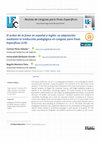
Revista de lenguas para fines específicos , 2019
Este trabajo estudia el papel de la traducción pedagógica L1 L2 en el aula de Lenguas para Fines ... more Este trabajo estudia el papel de la traducción pedagógica L1 L2 en el aula de Lenguas para Fines Específicos, dedicando atención especial al dominio del orden de las palabras en la oración. Para este fin, analizamos la competencia de dos grupos de estudiantes, españoles que estudian inglés para la informática, y estudiantes anglófonos que aprenden español dentro de su titulación en tecnologías de la información. El estudio se centró en los siguientes parámetros: sujeto explícito/implícito o tácito, sujeto antepuesto/pospuesto, estructura sintagma nominal, patrón verbo-objeto (VO) y oraciones pasivas y pasivas reflejas. Se diseñaron actividades de traducción para consolidar conocimientos y se evaluó su competencia en una prueba final. Los resultados comprueban que es el uso de las pasivas y las pasivas reflejas, tan frecuente en los textos técnicos, el más proclive a interferencias en la estructura de la frase, para los dos grupos de alumnado. Concluimos que la traducción pedagógica, como elemento innovador en el aula, influye muy positivamente en la consolidación de los aspectos gramaticales de las lenguas de especialidad por lo que proponemos su inclusión en los programas de cursos de Lenguas para Fines Específicos.
Revista de lenguas para fines específicos , 2019
The processes of euphemism and dysphemism have not been studied in depth in the field of Audiovis... more The processes of euphemism and dysphemism have not been studied in depth in the field of Audiovisual Translation (AVT). In this article, a deductive data analysis methodology is applied to the use of euphemism and dysphemism in six modern American science-fiction films (released between 2009 and 2015) in order to identify the behaviour of these processes. For this purpose, the original version in English and the subtitled and dubbed versions in Spanish have been analysed. As a result, it has been possible to find out what euphemisms and dysphemisms are used for, when they appear in the text and their frequency of use depending on the AVT mode used. From this data, it will be possible to determine if these linguistic processes are norms that translators use regularly to cope with the audiovisual restrictions in the texts.
Revista de lenguas para fines específicos , 2019
The present paper deals with the relationship between modality and evidentiality, focussed specif... more The present paper deals with the relationship between modality and evidentiality, focussed specifically on the use of the expression I think in combination with other modal devices, as well as the possible pragmatic effects observed in text samples obtained from the Coruña Corpus of English Scientific Writing and whether the variable of discipline might have some effect on the functions the expression represents in these texts. Even if much research is still to be done in academic texts from a diachronic perspective, there are some previous studies on stance devices carried out within the arena of historical pragmatics (cf.
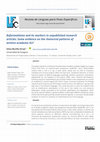
Revista de lenguas para fines específicos , 2019
This paper intends to contribute to the description of written academic English as a Lingua Franc... more This paper intends to contribute to the description of written academic English as a Lingua Franca (ELF) from an endonormative perspective (Seidlhofer, 2011). Reformulation markers (that is, that is to say, in other words, namely and i.e.) fulfil an interactive metadiscourse function (Hyland, 2007) and have been considered indicators of certain rhetorical aspects of different languages, specifically, whether expansions, clarifications, adjustments, etc. are frequent or not (Cuenca, 2003). Here I examine the frequency, functions, and (non-) parenthetical uses of these markers in the components of a corpus of unedited ELF research papers (the SciELF corpus, University of Helsinki). The findings indicate that the frequency of reformulation markers varies in the different L1 groups, with high rates in the Romance languages. The results also point to other ELF-related trends such as simplification/ specialization of the use of one marker (i.e.), and discourse explicitation, closely associated to the functions specification and explanation. Other outcomes may be related to a global academic context (with different disciplinary areas), of which ELF forms part (and they would not be ELF-specific). In conclusion, formal written academic ELF seems to constitute an "endorhetorical" use of the language.
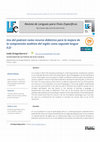
Revista de lenguas para fines específicos , 2019
In a society in which the ubiquitous learning or u-learning (anytime, anywhere) is present in our... more In a society in which the ubiquitous learning or u-learning (anytime, anywhere) is present in our everyday life and in which the teaching of a second language is not the teaching of a strict rules system, but of a system to obtain an efficient communication, the podcast is used as a didactic resource that helps students to develop the listening skill, in and out of the class. The main purpose of this article is a didactic proposal for the use of the podcast as a resource in the acquisition of a second language, in this study, English, emphasising not only the improvement in this skill, but also to diminish the student's anxiety and to increase self-esteem, two key factors in the process of learning a language. A questionnaire was made to determine if the use of the podcast and the proposed activities were positive and motivating in relation to the improvement of the listening skill. The first results show that this resource has not only didactic advantages, but it can also be used as a reinforcement for students to maintain the contact with L2 out of the classroom.
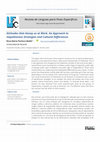
Revista de lenguas para fines específicos , 2019
This paper, which forms part of the research carried out for my doctoral dissertation, presents a... more This paper, which forms part of the research carried out for my doctoral dissertation, presents a new taxonomy of what I called social characteristics of individuals. This is a new approach that reorganises the traditional concepts of face and social rights. I named these social characteristics as follows: public image of singularity, public right of equality, public right of affiliation and public right of independence. These social characteristics are understood and emphasised differently by every culture. In other words, the characteristics will be dealt with by every cultural group in their own way, depending on and according to the cultural values of the group. Furthermore, these four social characteristics of individuals can be attacked or threatened with a series of impoliteness strategies. As an example, this article will analyse two of the most studied cultural dimensions: power and identity. To illustrate these ideas, I will present the data obtained from some questionnaires done by two groups of respondents, a Spanish one and an American one. The different values that these two cultures have will reflect on their answers.
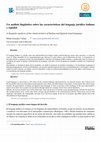
Revista de lenguas para fines específicos, 2020
RESUMEN El lenguaje jurídico se concibe como una subvariedad de la lengua común caracterizada por... more RESUMEN El lenguaje jurídico se concibe como una subvariedad de la lengua común caracterizada por rasgos muy concretos y se muestra como el reflejo inmutable de los comportamientos que subyacen en cada cultura y que la diferencian de otras. A tal propósito, el presente artículo se propone recoger las particularidades esenciales del lenguaje jurídico italiano y español para tener en cuenta en su análisis por parte de juristas y profesionales de la lengua, todo ello a través de numerosos ejemplos extraídos de la legislación vigente. Inicialmente se abordará el plano léxico-semántico, en donde la presencia de palabras extranjeras y la fraseología acapararán el principal protagonismo; el nivel morfosintáctico, por su parte, prestará especial atención a la nominalización y a los tiempos verbales usados en ambos idiomas; por último, el nivel ortográfico y estilo se centrará principalmente en el uso de siglas y abreviaturas y en el oscurantismo del lenguaje jurídico.
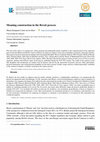
Revista de lenguas para fines específicos , 2020
The aim of this study is to explore how verbal, pictorial and multimodal modes contribute to the ... more The aim of this study is to explore how verbal, pictorial and multimodal modes contribute to the communication of the separation process between Britain and the EU, known as Brexit, by means of cognitive tools such as metaphor, metonymy and image schemas. This analysis has been structured according to the Conceptual Metaphor Theory (Lakoff & Johnson 1980; Charteris-Black & Musolf, 2003; Charteris-Black, 2004, Ruiz de Mendoza & Pérez, 2011, among others) and the Theory of Multimodal Discourse (Forceville 1996, 2006, 2009, 2012; Forceville & Urios-Aparisi, 2009). The data collected for analysis consists of some covers of The Economist magazine, dealing with different stages of the process, published during the 2015-2017 period. The results of the analysis reveal that metaphors and metonymies are usually cued by pictures and also by the interaction of pictures and text. More particularly, pictorial metonymies and verbal-pictorial metaphors are the most recurrent. Finally, image schemas, rendered pictorially, contribute to the creation of negative evaluative meaning in the corpus selected.
Revista de lenguas para fines específicos, 2020
En este artículo damos cuenta de la incidencia del contexto jurídico y bilingüe en la enseñanza-a... more En este artículo damos cuenta de la incidencia del contexto jurídico y bilingüe en la enseñanza-aprendizaje del francés jurídico (FOS). Así, fenómenos como la diglosia, bilingüismo y bijuridismo repercuten en la configuración de un sistema jurídico. Para ello, se toma como ejemplo Marruecos como país del Magreb francófono cuyo sistema jurídico está caracterizado tanto por una dualidad jurídica (derecho islámico y derecho francés) como lingüística (árabe y francés). El análisis del corpus representativo revela que las asimetrías conceptuales entre dos sistemas jurídicos expresados en lengua francesa solo se pueden enseñar y aprender aplicando un enfoque contextual e intercultural.
Revista de lenguas pa ra fines específicos, 2020
The goal of this paper is to analyze the terminology of the only full translation of the book Phy... more The goal of this paper is to analyze the terminology of the only full translation of the book Physicalische Beschreibung der Canarischen Inseln by Buch carried out by Delgado Luis (von Buch, 1999). In order to achieve this goal, we perform the extraction of all the terms of the book by using Trados SDL MultiTerm Extract and creating a terminological data base. Analyzing this data base, we study the terms used in the translation: terminological density, methods of term formation and strategies of translation. With all this, we determine de terminogical adequacy of the translated book contributing with a new knowledge of this importart text.
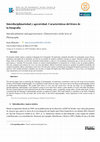
Revista de lenguas para fines específicos, 2020
El presente estudio aspira a explorar el lenguaje de la fotografía. En particular, pretende descu... more El presente estudio aspira a explorar el lenguaje de la fotografía. En particular, pretende descubrir los principales rasgos léxicosemánticos del inglés de la fotografía. Se trata de un estudio de carácter cualitativo basado en corpus. Nuestras fuentes han sido blogs sobre la fotografía, escritos por fotógrafos profesionales y nativos. Los resultados demuestran que se trata de un léxico de gran riqueza y variedad. Por una parte, destaca su carácter interdisciplinario; la fotografía no se limita a usar sus propias palabras, sino que comparte gran número de voces con otras disciplinas. Hemos localizado numerosos ejemplos de palabras heredadas del campo de la pintura, óptica, informática, entre otros. Por otra parte, hemos concluido que el lenguaje fotográfico presenta un carácter agresivo. Este estudio pretende contribuir, por un lado, al campo del Inglés para Fines Específicos, y, por el otro, a la fotografía, cuya importancia en la sociedad actual está creciendo.
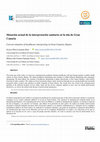
Revista de lenguas para fines específicos , 2020
The main aim of this study is to discover communication problems between healthcare staff and for... more The main aim of this study is to discover communication problems between healthcare staff and foreign patients at public health centres in Gran Canaria (Spain). We define healthcare interpreting after framing it within bilateral interpreting and community interpreting. We then address the situation of healthcare interpreting in Spain (specifically, in the Canary Islands), which differs from that of other countries. We outline an observational descriptive study carried out through surveys among health and non-health personnel (office workers and orderlies) at public hospitals in Gran Canaria. The results show the extent of the communication problem at the different hospital services under study and the ad hoc solutions applied in most cases by health professionals themselves, as well as the almost total absence of professional interpreters.
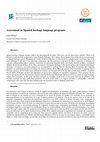
Revista de lengua s para fines específicos , 2020
Spanish heritage language learners (HLLs) are heterogeneous in nature. Thus, how can we assess th... more Spanish heritage language learners (HLLs) are heterogeneous in nature. Thus, how can we assess these students? Most of the literature on this has been on placement exams (Polinsky & Kagan, 2017, among others), but the focus of this article is on assessment in Spanish heritage courses. Placement test results should be indicators of what should be included in the curriculum. One of the main challenges is the lack of the following components: specific proficiency indicators for HLLs, consensus in defining key concepts, understanding dialect variation, assessment for measuring linguistic skills, and finally research on HLLs' assessment (Malone, Kreeft Peyton, & Kim, 2014). Thus, assessment is the biggest challenge in HL education due to the dominant monolingual ideologies, so formative assessment practices are recommended to confront them by allowing HLLs to negotiate their linguistic identities via multilingual perspectives (King, Liu, & Schwedhelm, 2018). What are specific tools or activities to negotiate these? Personal narratives of US Latinx were collected by Carreira and Beeman (2014) for the sake of reflections of HLLs. González-Davies (2004, 2018) also mentions the importance of peer-to-peer strategies for translation competence. These projects can also become group projects, like the manifestos implemented by Moreno and MacGregor-Mendoza (2019) in a course in which language, culture, and community are the goals. All these activities are examples of the kinds of assessment that may be effective in the heritage classroom and may guide their instructors. The goal of this article is to suggest activities to connect HLLs with their communities at the same time that their learning gains are assessed in terms of language proficiency.
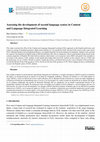
Revista de lenguas para fines específicos , 2020
This study examined the effect of the Content and Language Integrated Learning (CLIL) approach on... more This study examined the effect of the Content and Language Integrated Learning (CLIL) approach on the English proficiency and syntax of a group of Andalusian learners. High-school students (n = 22) enrolled in CLIL and non-CLIL classes in the same school (I.E.S. Mariana Pineda) took an English proficiency test adapted from the University Entrance Examination. Students were assessed for syntactic development in English using an Elicited Imitation (EI) task in conjunction with an experimental design based on the syntactic properties of English. Pre-intervention academic achievement, socioeconomic status (SES), and gender were included as covariates in the analyses. CLIL students scored significantly higher than non-CLIL students on the syntactic task (p = 0.002) and the proficiency test (p < 0.001). Results revealed a significant positive correlation between the scores obtained in the proficiency test and the EI task for the CLIL group (p < 0.01), but not for the non-CLIL group (p = 0.39). These findings advance a methodology to assess the English syntax of CLIL students.
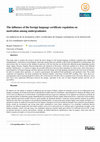
Revista de lenguas para fines específicos, 2021
This paper aims to analyse the extent to which the latest changes to the foreign language certifi... more This paper aims to analyse the extent to which the latest changes to the foreign language certificate regulation have influenced undergraduates' motivation to learn English, especially among final year students at the Centro de Magisterio La Inmaculada. The main reason why we focused on the students in question is the fact that they are divided into different groups depending on their major subject (Science, English, Physical Education and Attention to Diversity), which has enabled us to observe four different profiles. Furthermore, we wanted to explore the possible differences between them regarding two main issues: their motivation to study English as a Foreign Language and their opinions about the change in foreign language regulation at the University of Granada. In order to examine these questions, we created a questionnaire that gathered both quantitative and qualitative data. The results confirmed our hypothesis: the latest regulation has affected students' motivation towards EFL learning. Now, more than ever, undergraduates opt for learning English to obtain a B1 certificate that will allow them to graduate from University. Moreover, there have been some significant differences between the groups, especially in the case of future English teachers and the rest of specialities.
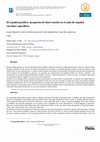
Revista de lenguas para fines específicos , 2021
Es bien sabido que para el correcto aprendizaje de una lengua, además de conocer las reglas grama... more Es bien sabido que para el correcto aprendizaje de una lengua, además de conocer las reglas gramaticales, el léxico y demás normas formales, también se debe conocer la cultura relacionada con la misma. La cuestión principal cuando se trata este asunto es qué cultura llevar al aula, pregunta que se acentúa cuando tratamos las lenguas de especialidad. El presente artículo trata de definir qué son las lenguas de especialidad en general y de presentar las características del español jurídico en concreto. Además, y en consonancia con lo mencionado anteriormente, también se trata la “cultura profesional”, es decir, los usos y costumbres que tienen los operadores jurídicos españoles en el ejercicio de su profesión.
Además de este enfoque teórico, también se plantea una propuesta de intervención, concretamente, se trata de una unidad didáctica basada en un caso real de derecho penal. Esta propuesta incluye una serie de actividades variadas que tienen como objetivo trabajar contenidos gramaticales, léxicos, de tipología discursiva propios del español jurídico así como de la cultura profesional jurídica. Estos contenidos se presentan a través de un caso real que acompaña al alumno desde el principio hasta el final de la unidad didáctica y del cual forma parte activamente, ya sea como acusación o como defensa.



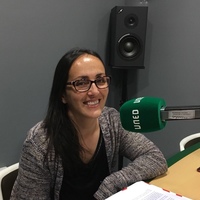






Uploads
Papers by Journal Revista de lenguas para fines específicos
Además de este enfoque teórico, también se plantea una propuesta de intervención, concretamente, se trata de una unidad didáctica basada en un caso real de derecho penal. Esta propuesta incluye una serie de actividades variadas que tienen como objetivo trabajar contenidos gramaticales, léxicos, de tipología discursiva propios del español jurídico así como de la cultura profesional jurídica. Estos contenidos se presentan a través de un caso real que acompaña al alumno desde el principio hasta el final de la unidad didáctica y del cual forma parte activamente, ya sea como acusación o como defensa.
Además de este enfoque teórico, también se plantea una propuesta de intervención, concretamente, se trata de una unidad didáctica basada en un caso real de derecho penal. Esta propuesta incluye una serie de actividades variadas que tienen como objetivo trabajar contenidos gramaticales, léxicos, de tipología discursiva propios del español jurídico así como de la cultura profesional jurídica. Estos contenidos se presentan a través de un caso real que acompaña al alumno desde el principio hasta el final de la unidad didáctica y del cual forma parte activamente, ya sea como acusación o como defensa.